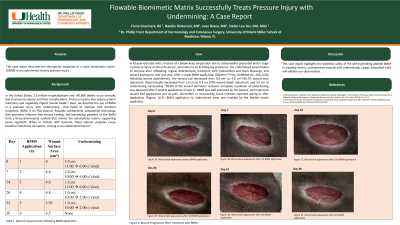Case Series/Study
(CS-059) Flowable Biomimetic Matrix Successfully Treats Pressure Injury with Undermining: A Case Report
Friday, May 2, 2025
7:45 PM - 8:45 PM East Coast USA Time

Natalie Hickerson, MD; Juan Bravo, MD; Hadar Lev-Tov, MD, MAS
Introduction: Pressure injuries account for 2.5 million hospitalizations in the United States, making it the third most costly disease, with more than 60,000 deaths resulting from disease complications. Pressure injuries also reduce patient autonomy, contribute to self-care dysfunction and result in poor mental health for the patient [1]. Here, we describe the use of a novel BMM in a pressure injury that failed to improve with standard treatment. BMM is an FDA-cleared, flowable antibacterial polypeptide technology that promotes infection-free wound healing. The BMM self-assembling peptides form a three-dimensional scaffold that mimics the extracellular matrix (ECM), supporting tissue regrowth. In addition, when in contact with bacteria, these cationic peptides cause bacterial membrane disruption, serving as an antibacterial barrier [2]. This case report describes the therapeutic outcomes from application of a novel biomimetic matrix (BMM)* in a chronic pressure injury with undermining.
Methods: A 43-year-old male presents with a stage 3 pressure injury on the left sacrum secondary to an ill-fitting leg prosthesis, causing him to put more weight on his left sacrum. He received his prosthesis after receiving a below-knee amputation for osteomyelitis of his right heel. He failed to improve after offloading, and treatment with hydrocolloid dressings, foam dressings, and wound packing for over one year.
Results: After a single BMM application with the flexible applicator tip and following wound debridement, the wound size decreased from 9.0 cm2 to 4.8 cm2 (46.7% wound area reduction). Wound depth decreased from 1.0 cm to 0.3 cm, and 3.0 cm undermining surrounding about 58.0% of the wound perimeter completely resolved. Resolution of undermining was observed after 5 weekly applications. The BMM was simple to apply and well-tolerated by the patient, with no pain or discomfort during or after application, and no surrounding irritation of the tissue with improved wound bed appearance.
Discussion: This case report highlights the potential utility of the self-assembling peptide BMM in treating chronic, unresponsive wounds with undermining. Larger, controlled trials will validate our observation.
Methods: A 43-year-old male presents with a stage 3 pressure injury on the left sacrum secondary to an ill-fitting leg prosthesis, causing him to put more weight on his left sacrum. He received his prosthesis after receiving a below-knee amputation for osteomyelitis of his right heel. He failed to improve after offloading, and treatment with hydrocolloid dressings, foam dressings, and wound packing for over one year.
Results: After a single BMM application with the flexible applicator tip and following wound debridement, the wound size decreased from 9.0 cm2 to 4.8 cm2 (46.7% wound area reduction). Wound depth decreased from 1.0 cm to 0.3 cm, and 3.0 cm undermining surrounding about 58.0% of the wound perimeter completely resolved. Resolution of undermining was observed after 5 weekly applications. The BMM was simple to apply and well-tolerated by the patient, with no pain or discomfort during or after application, and no surrounding irritation of the tissue with improved wound bed appearance.
Discussion: This case report highlights the potential utility of the self-assembling peptide BMM in treating chronic, unresponsive wounds with undermining. Larger, controlled trials will validate our observation.

.jpg)